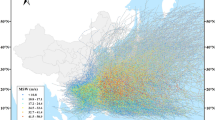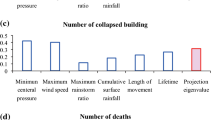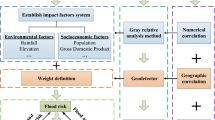Abstract
In recent years, tropical cyclones on the Pacific Northwest have decreased. We cannot infer that tropical cyclones impact China have reduced, because the Pacific Northwest is not homogeneous, and the variation characteristics of tropical cyclones in different sea areas are not clear. This paper uses gray relational density clustering algorithm to cluster tropical cyclone data sets between 1949 and 2008, according to the generated position of tropical cyclones, generated density and the possibility of landing. The Pacific Northwest is divided into different sea areas. Then, we analyze the risk of tropical cyclones generated in these sea areas. The results show that the probability of tropical cyclones landing generated in some sea areas is very high, reached 74 %, but the probability of tropical cyclones landing generated in other sea areas is only 2 %. Tropical cyclones generated in some sea areas are more likely to develop into typhoons, strong typhoons and so on, but the intensity of tropical cyclones generated in other sea areas is lower, there is little risk for China. Finally, according to the climate change stage trends, we divide the period 1949–2008 into three stages and analyze the tropical cyclone risk of each sea areas.








Similar content being viewed by others
References
Dessai S (2003) The special climate change fund: origins and prioritization assessment. Clim Policy 3(3):295–302
Ester M, Kriegel HP, Sander J, Xu X (1996) A density-based algorithm for discovering clusters in large spatial databases with noise. KDD-96 Proceedings AAAI Press: 226–232
Han JJ, Bai LN, Wang D, Wang Y (2007) “Science” and “Nature” hot issues on Typhoon research. Nanjing Univ Sci Technol (Nat Sci) 43(06):681–694
IPCC (2007) Climate change 2007: synthesis report Geneva, Switzerland: the intergovernmental panel on climate change: 1–104
Knight J, Kennedy JJ, Folland C, et al. (2009) Do global temperature trends over the last decade falsify climate predictions? In state of the climate in 2008. Bull Am Meteor Soc: 22–23
Levitus S, Antonov J, Boyer T (2005) Warming of the world ocean, 1955–2003. Geophys Res Lett 32(2):15. doi:10.1029/2004GL021592
Ma EWM, Chow TWS (2004) A new shifting grid clustering algorithm. Pattern Recognit 37(3):503–514
Ma LP, Chen LS, Xu XD (2006) On the characteristics of correlation between global tropical cyclone activities and global climate change. J Trop Meteor 22(2):147–154
Muni KK (2009) Intensifying tropical cyclones over the North Indian Ocean during summer monsoon—global warming. Glob Planet Change 65(1):12–16
Tan XR, Deng JL (1995) Gray relational analysis: multivariate statistical analysis of the new method. Stat res 65(03):46–48
Tang GL, Ren GY (2005) Reanalysis of nearly a century surface air temperature trend. Clim Environ Res 10(04):791–798
Wang GH, Su JL, Ding YH et al (2007) Tropical cyclone genesis over the south China sea. J Mar Syst 68(1):318–326
Wen KG (2006) The Chinese the meteorological disasters ceremony—Zhejiang volumes. 1 Beijing: China Meteorological Press pp 11
Yan GH, Li QP, Xing C (2011) Future surface air temperature changes in China under different greenhouse gas emission scenarios. J Nanjing Univ Inf Sci Technol (Nat Sci Edition) 3(1):36–46
Yang YX (2005) Northwest Pacific tropical cyclones occur. Mar forecast 22(01):86–91
Yang YH, Ying M, Chen BD (2009) Landing the Chinese tropical cyclone climate variation in the past 58 years. Meteor Sci 67(05):689–696
Yu YB, Yao XP (2010) The Chinese the offshore tropical cyclone intensity mutation heat characteristics of Meteorological. Science 68(01):48–58
Zahibo N, Pelinovsky E, Talipova T et al (2007) Statistical analysis of cyclone hazard for Guadeloupe, lesser antilles. Atmos Res 84(1):13–29
Zhang QH, Wei Q, Chen LS (2010) Typhoon influence in mainland China. Chin Sci: earth Sci 40(07):941–946
Acknowledgments
This work was financially supported by the National Natural Science Foundation of China (No. 71173116), the National Natural Science Foundation of China (No. 71171115), the Project Funded by China Institute of Manufacturing Development (SK20120200-3), and the Project Funded by China Institute of Manufacturing Development (SK20120200-7). A Project Funded by the Priority Academic Program Development of Jiangsu Higher Education Institutions.
Author information
Authors and Affiliations
Corresponding author
Rights and permissions
About this article
Cite this article
Zhang, L.J., Zhu, H.Y. & Sun, X.J. China’s tropical cyclone disaster risk source analysis based on the gray density clustering. Nat Hazards 71, 1053–1065 (2014). https://doi.org/10.1007/s11069-013-0700-4
Received:
Accepted:
Published:
Issue Date:
DOI: https://doi.org/10.1007/s11069-013-0700-4




